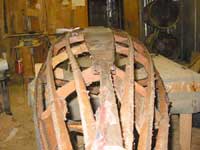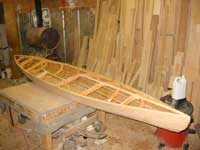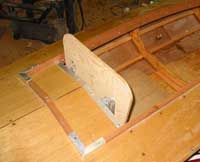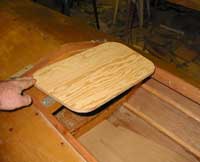|
Phoenix
by Pat Patteson
The 15 foot Kayak is built of cheap 1/4"- Luann using an old, delapidated Folbot "Sporty" for rib, bow and stern and bottom patterns.
Hence the name, "Phoenix" as the boat has risen from what may have been a fiery end to that old Folbot.
|
|
 |
Here I am in the "Phoenix" at the Depoe Bay Wooden Boat Festival and Crab Feed. (photos by John Kohnen)
(click images for larger views)
|
|
I would not recommend anyone else try this. I know I am writing this article about how I built this boat, but I don't want to encourage anyone else to try what I did. There Are Better ways to build a Kayak.
The construction is similar to a ridged Folbot, but with Ply strakes on longitudinal stringers over frames rather than fabric covered.
I built a ridged Folbot "Super" from a Folbot Kit over 20 years ago and stored out of the elements when not in use is still in pretty good shape and used regularly.
|
|
 |
the "Phoenix" before...
|
|

... after a bit of cleaning...
|
|
|
But, plywood, even thin plywood like the Luann behaves very differently than fabric. There are some nasty twists to the garboards.
The bottom and frames are 1/2 fir plywood, copied as closely as I could to the rotted frames of the old boat.
Several frames had to be modified to get the plywood strakes to lay fair.
(or pretty close to fair.)
The planks are laid against each other, similar to stitch a glue construction, but attached to the stringers rather than just stitched together before glassing. The bottom and stringers are simply butt jointed, similarly to Folbot construction.
|
|

... with the bottom planked |
|
The strakes use a "Payson", fiberglass, butt joint, about in the middle of the boat.
The original fabric was too bad to use as patterns for the new strakes so each one had to be cut to fit (they Are the same on both sides). The fabric patterns would not have worked anyway, as the plywood did not lay the same as the fabric.

bow view
|
 looking through the frames
looking through the frames |
|
The kayak is covered, deck and bottom with 6oz glass (epoxy and glass from Duckworks) with extra glass on the wear areas. The interior is just Oiled as not to lock in any water.
The result is a Very Stiff, if somewhat heavy kayak. The performance is as good or better than I had hoped and it seems to move through the water a little better than the old Ridged Frame, Fabric Covered, Folbot "Super" I still use.
|
|
... with the deck on and glassed |
|
It's not as Fast as a narrow kayak, but a Lot more stable. I can live with a little less speed, but getting too Old to Roll.
I was curious to see how the performance of the ply covered boat would compare to the flexible Folbot fabric covered one, and the ply Seems to be better. I guess, theoretically there is less resistance than that caused by the flexing fabric.
The Only parts from the old "Sporty" that are part of "Phoenix" are the Folbot aluminum bow and stern castings, which do give the boat a nice, finishing touch. Unfortunately, the cockpit castings were missing from the old boat so I had to manufacture the aft corner covers from hardware store aluminum angle, and the forward point of wood.
The cockpit coaming is mahogany I had laying around the shop, laminated in 2 strips, and that too adds a more finished look to the boat. It was not designed as a "Gold Plater" and this boat, other than the coaming, will be painted with latex house paint like the rest of my boats. They Are All "Work Boats". "Messing About" in them can be Really Hard Work.<g>
I also used hardware store aluminum angle to fabricate some hinges for the "Folbot" style seat back that allow the back to swivel some, for comfort and to tip up flat to be used as a seat for sitting on the top of the deck. But, this boat is narrower than my "Super" so it is a lot more precarious to sit high, like that. I'll stay in the Bottom of this boat.

aluminum angle hinge
|
 seat back up
seat back up |
|
The cockpit Is a tight squeeze, but once in and seated on the bottom, the boat is very stable, and I would have to really work to get it to "Roll".
The beam is almost 32 inches. With the relatively high freeboard and combing a spray skirt shouldn't be necessary in most water.
So far, just an old curtain rod, plywood blade paddle, but I will build an offset paddle when I decide what length it should be. I am of the "Offset" blade persuasion.
I had "Phoenix" displayed and in the water at the Depoe Bay Wooden Boat Festival and Crab Feed this last April.
I have to admit, the boat did leak a little. In the rush to get the boat done by the Festival time I put the boat in the water before it was completely finished and had forgotten to put in the inside layer of glass on the "Payson Butt" strake joints for the garboards. With just a single Wetting" coat of epoxy on the outside of the boat a slight trickle of water seeped in, right in front of the seat. Oops ! !
There were a lot of confused looks from folks at the Festival, saying "It Looks like a "Folbot", but it's made of plywood?"
I have intended to build this boat since I bought the old, rotted Folbot years ago.
I'm pretty happy with the outcome.
Now to get all the weave filled. the boat painted and Really Finished.
Building Photos by Pat Patteson
Pat Patteson
Molalla, Oregon
|

